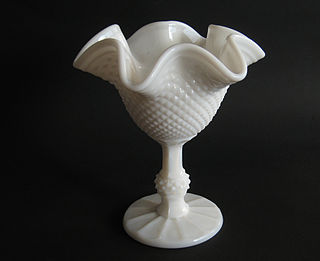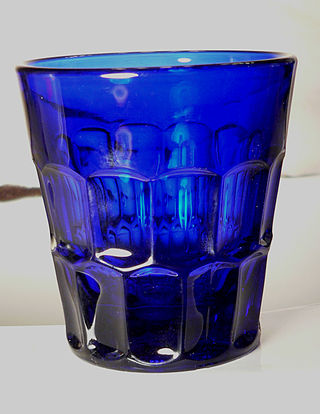
Fire-King is an Anchor Hocking brand of glassware similar to Pyrex. It was formerly made of low expansion borosilicate glass and ideal for oven use. Currently it is made of tempered soda-lime-silicate glass in the US and borosilicate in Japan

Depression glass is glassware made in the period 1929–1939, often clear or colored translucent machine-made glassware that was distributed free, or at low cost, in the United States and Canada around the time of the Great Depression. Depression glass is so called because collectors generally associate mass-produced glassware in pink, yellow, crystal, green, and blue with the Great Depression in America.

Milk glass is an opaque or translucent, milk white or colored glass that can be blown or pressed into a wide variety of shapes. First made in Venice in the 16th century, colors include blue, pink, yellow, brown, black, and white.

Sea glass are naturally weathered pieces of glass, which often have the appearance of tumbled stones. Sea glass is physically and chemically weathered glass found on beaches along bodies of salt water. These weathering processes produce natural frosted glass. Sea glass is used for decoration, most commonly in jewellery. "Beach glass" comes from fresh water and is often less frosted in appearance than sea glass. Sea glass takes 20–40 years, and sometimes as much as 100–200 years, to acquire its characteristic texture and shape. It is also colloquially referred to as drift glass from the longshore drift process that forms the smooth edges. In practice, the two terms are used interchangeably.
Bakewell Glass is nineteenth-century glassware from Pittsburgh, Pennsylvania, produced by a company founded by Benjamin Bakewell. Bakewell's company can be found under the names ThePittsburgh Glass Manufactory, Bakewell & Page and, Bakewell, Pears & Co. Bakewell glass built a reputation of being both luxurious and utilitarian during the 80 years it was in business.

Corelle is a brand of glassware and dishware. It is made of Vitrelle, a tempered glass product consisting of two types of glass laminated into three layers. It was introduced by Corning Glass Works in 1970, but is now manufactured and sold by Corelle Brands.

The A.H. Heisey Company was formed in Newark, Ohio, in 1895 by A.H. Heisey. The factory provided fine quality glass tableware and decorative glass figurines. Both pressed and blown glassware were made in a wide variety of patterns and colors. The company also made glass automobile headlights and Holophane Glassware lighting fixtures. The company was operated by Heisey and his sons until 1957, when the factory closed.
The Westmoreland Glass Company was a company that produced glass in Grapeville, Pennsylvania.
The Fostoria Glass Company was a manufacturer of pressed, blown and hand-molded glassware and tableware. It began operations in Fostoria, Ohio, on December 15, 1887, on land donated by the townspeople. The new company was formed by men from West Virginia who were experienced in the glassmaking business. They started their company in northwest Ohio to take advantage of newly discovered natural gas that was an ideal fuel for glassmaking. Numerous other businesses were also started in the area, and collectively they depleted the natural gas supply. Fuel shortages caused the company to move to Moundsville, West Virginia, in 1891.
The United States Glass Company was a trust formed by the combination of numerous glass companies. The factories were located from western Pennsylvania to Indiana.

Elegant glass is high quality glassware created in the United States during the Depression Era. It was sold for high prices in department stores and given as wedding gifts. Although part of the Depression Era, it is considered by most to be a separate category or sub category of Depression glass. When new, Elegant glass would cost more than standard Depression glass, because it was at least partially handmade, had a cleaner finish, and more vibrant colors. From the 1920s through the 1950s, Elegant glass was an alternative to fine china. Most of the Elegant glassware manufacturers closed by the end of the 1950s, and cheap glassware and imported china took its place.

The Hostmaster Pattern was manufactured by New Martinsville Glass Company during the 1930s. Though the line was extensive, New Martinsville Hostmaster Pattern is one of the lesser known patterns of Elegant Glass. There are no reproductions as the mold was melted down to make the Raindrops pattern.

The New Martinsville Glass Company was an American manufacturer of decorative glass products. It opened in 1901 in New Martinsville, West Virginia. The company was renowned for the use of color in their glassware. They initially made tableware but quickly expanded into vanities, bare ware, lamps, and more. They promoted liquor sets even through prohibition. The company was renamed Viking Glass in 1944.
Early American molded glass refers to glass functional and decorative objects, such as bottles and dishware, that were manufactured in the United States in the 19th century. The objects were produced by blowing molten glass into a mold, thereby causing the glass to assume the shape and pattern design of the mold. When a plunger rather than blowing is used, as became usual later, the glass is technically called pressed glass. Common blown molded tableware items bearing designs include salt dishes, sugar bowls, creamers, celery stands, decanters, and drinking glasses.
Seneca Glass Company was a glass manufacturer that began in Fostoria, Ohio, in 1891. At one time it was the largest manufacturer of blown tumblers in the United States. The company was also known for its high-quality lead (crystal) stemware, which was hand-made for nearly a century. Customers included Eleanor Roosevelt and Lyndon B. Johnson, and retailers such as Marshall Field and Company, Neiman Marcus, and Tiffany's.

Pairpoint Glass Company is an American glass manufacturer based in Sagamore, Massachusetts. It is currently the oldest operating glass company in the United States.
Indiana Glass Company was an American company that manufactured pressed, blown and hand-molded glassware and tableware for almost 100 years. Predecessors to the company began operations in Dunkirk, Indiana, in 1896 and 1904, when East Central Indiana experienced the Indiana gas boom. The company started in 1907, when a group of investors led by Frank W. Merry formed a company to buy the Dunkirk glass plant that belonged to the bankrupt National Glass Company. National Glass was a trust for glass tableware that originally owned 19 glass factories including the plant in Dunkirk. National Glass went bankrupt in 1907, and its assets were sold in late 1908.
The Lancaster Glass Company was a producer of manufactured glassware in Lancaster, Ohio that ran from 1908 to 1937. They are a producer of depression glass and were known as an early innovator of color in depression-era glassware.











